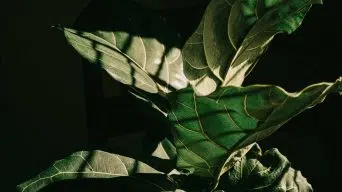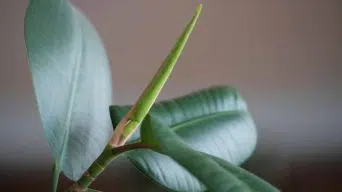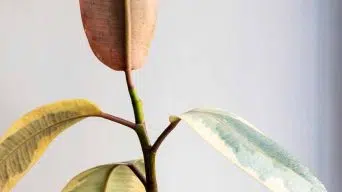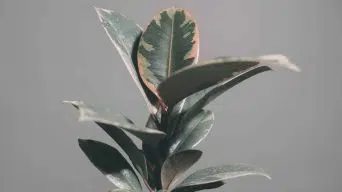The decline of a rubber plant could be due to various factors, such as improper watering, insufficient light, or the need for repotting. To revive your plant, water it evenly, provide adequate sunlight (a few hours of direct sun), and consider repotting if necessary.
Are you experiencing heartache at the sight of your treasured rubber plant’s waning health? Fret not!
It’s no secret that even the most seasoned indoor gardeners find themselves confronting a wilting leaf or two.
Fortunately, you’ve stumbled upon the right spot. Roll up your sleeves as we delve into potential causes and remedies to nurse your rubber plant back to robust health.
Here’s an insider’s guide to understand the woes of a struggling rubber plant and expert tips on how it can be successfully revived – just like magic.
Facts and Statistics
- According to a 2017 survey, overwatering is the cause of approximately 70% of indoor rubber plant deaths.
- Research shows that inadequate sunlight, which affects nearly 50% of indoor plants, can lead to leaf drop in rubber plants.
- An investigation by the University of Florida noted that repotting stress leads to temporary drooping or wilting in around 60% of indoor rubber plant cases.
Diagnosing a Struggling Rubber Plant
If you’ve noticed that your rubber plant looks less than vibrant and healthy, it’s important to diagnose the cause of its struggles.
By understanding the underlying issues, you can take appropriate steps to revive your struggling houseplant.
Here are some factors to consider when diagnosing a struggling rubber plant:
Signs of Improper Watering
One of the most common mistakes that plant owners make is improper watering.
Finding the right balance between too much and too little water can be a challenge, but it is crucial for the health of your rubber plant.
Overwatering and underwatering are two opposite ends of the spectrum, each having its own telltale signs.
Let’s start with overwatering. If you notice that the leaves of your rubber plant are turning yellow and becoming mushy, this is a clear indicator that you’ve been giving it too much water.
Additionally, if you see fungus gnats buzzing around the soil or feel excessive moisture when you touch it, odds are your plant is drowning in water.
Over time, overwatered plants may also develop root rot, causing them to become weak and susceptible to other diseases.
On the other hand, underwatering can also wreak havoc on your rubber plant’s health. When a plant does not receive enough water, its leaves may curl and turn brown at the edges.
The soil will feel dry to the touch, and the plant may wilt or droop visibly. In severe cases of underwatering, the leaves may become crispy and fall off prematurely.
Now, some might argue that it’s better to underwater than to overwater since underwatered plants have a higher chance of survival compared to their overwatered counterparts.
While this statement has some truth, it’s important to remember that neither extreme is ideal for your rubber plant’s long-term health. Just as humans need a consistent water supply to thrive, so do our leafy friends.
Finding the sweet spot when it comes to watering requires observation, patience, and a willingness to adjust based on your plant’s individual needs.
Suppose you have a busy schedule and tend to forget to water your rubber plant. One day, you notice that the leaves are excessively dry and crisping up around the edges.
You quickly realize that you’ve been underwatering it.
To remedy the situation, you begin regularly watering it, ensuring the soil is evenly moist but not waterlogged. Over time, you witness the leaves gaining their vibrant color back and regaining their turgidity.
Think of your rubber plant’s roots as a delicate ecosystem, like a thriving underwater coral reef.
Just as too much or too little light can harm marine life in a reef, improper watering can upset the balance within your plant’s root system.
When you provide the right amount of moisture, you create an environment where nutrients can be absorbed efficiently and oxygen can reach the roots.
This equilibrium allows your rubber plant to grow stronger, develop new leaves, and flourish in its pot.
Effects of Insufficient Light
Insufficient light is one of the primary reasons your rubber plant may be struggling.
Rubber plants thrive in bright, indirect light and require a minimum of 6-8 hours of sunlight daily.
Insufficient light can have several detrimental effects on your rubber plant:
When a rubber plant doesn’t receive enough light, it can lead to stunted growth and leggy stems.
The plant may start stretching towards the nearest light source in an attempt to capture more sunlight, resulting in elongated and weak stems.
The leaves may become smaller, pale, or discolored, losing their vibrant green hues.
Another effect of insufficient light is leaf drop. As the plant tries to conserve energy, it sheds its lower leaves to redirect resources to support new growth at the top. I
f you notice leaves yellowing and falling off, it’s a sign that your rubber plant is not receiving adequate light.
Furthermore, insufficient light can weaken the plant’s health, making it more susceptible to diseases and pests.
To ensure your rubber plant flourishes, provide it with ample indirect sunlight throughout the day.
Placing it near a south-facing window or using artificial grow lights can help compensate for inadequate natural lighting.
Identifying Diseases and Pests
Rubber plants are not immune to diseases and pest infestations, even with proper lighting conditions.
Recognizing the signs early on can help you take swift action and prevent further damage.
Here are some common diseases and pests that can affect your rubber plant:
- Root Rot: Overwatering or poor drainage can cause root rot in rubber plants. Yellowing and wilting leaves, a foul smell from the soil, and soft roots are indicators of this fungal infection.
- Scale Insects: These tiny oval-shaped pests attach themselves to the underside of leaves and stems, sucking out the plant’s sap. Look for small brown bumps on the plant’s surface and sticky residue left by the insects.
- Mealybugs: Mealybugs are white, cottony insects that cluster on the underside of leaves and along stems. They feed on the plant’s sap, causing yellowing or distorted growth. Look for fluffy, mealy formations in these areas.
- Leaf Spot Diseases: Fungal or bacterial leaf spot diseases can cause dark brown or black spots on rubber plant leaves. Over time, these spots may enlarge and start to affect larger parts of the foliage.
It is crucial to take appropriate measures if you spot any signs of diseases or pests on your rubber plant.
Isolate the infected plant from others to prevent further spread, then treat it with suitable remedies such as neem oil for insect infestations or fungicides for fungal diseases.
Steps to Revive Your Rubber Plant
Is your once vibrant rubber plant now showing signs of struggle and decline? Don’t despair!
With the right care and attention, you can revive your struggling houseplant and return it to its former glory.
Let’s explore some practical steps you can take to breathe new life into your rubber plant.
First and foremost, assess the current condition of your plant and identify any potential issues that might be contributing to its decline. A
sk yourself questions such as: Is the plant receiving the right amount of light? Are the watering techniques appropriate? Is the humidity level suitable for a rubber plant?
By understanding your plant’s specific needs, you can tailor your revival efforts accordingly.
Improper watering is a common issue that can hinder a rubber plant’s health. It’s essential to strike a balance between moist soil and well-drained roots.
When watering a rubber plant, ensure that all parts of the soil are evenly moistened, but avoid overwatering that leads to waterlogged roots.
A good rule of thumb is to water thoroughly when the top inch of soil feels dry, allowing excess water to drain completely.
Additionally, it’s advisable to aerate the soil occasionally by gently loosening it with a small garden fork or stick. This practice helps maintain proper oxygen levels in the root zone and minimizes the occurrence of black spots on leaves.
Another crucial factor in reviving your struggling rubber plant is providing adequate light and humidity levels.
Rubber plants generally thrive in bright, indirect light but can tolerate some direct sunlight for a few hours each day.
If your plant is not receiving enough light, consider relocating it to a spot closer to a window where it can receive about 2 hours of direct sun daily.
On the other hand, if you notice that your rubber plant is exposed to intense sunlight throughout the day, which may cause leaf burn or stress, consider moving it to a slightly shadier location or using sheer curtains to filter the light.
Finding the right balance of light for your specific plant is crucial for its overall health and growth.
In terms of humidity, rubber plants appreciate moderately humid environments.
Consider increasing humidity levels around your plant if you live in a dry climate or have overly dry conditions indoors.
You can do this by placing a tray filled with water near the plant or by using a room humidifier. Alternatively, misting the leaves regularly can also provide some moisture to the plant.
Taking these steps to revive your struggling rubber plant will require patience and perseverance.
Remember that lower leaves naturally fall off over time, so occasional leaf loss is normal.
With consistent care, proper watering techniques, and adjustments to light and humidity levels, you can restore your rubber plant to its former beauty and enjoy its lush presence in your home.
Correct Watering Techniques
As mentioned earlier, correct watering techniques are vital in reviving a struggling rubber plant. To ensure optimal health and growth, it’s important to understand how to water your plant effectively.
When watering a rubber plant, thoroughly moisten all parts of the soil until excess water starts to drain away from the pot’s drainage holes. This allows the roots to absorb moisture evenly throughout the soil and helps prevent potential waterlogged conditions that can lead to root rot.
It’s worth noting that the watering frequency will depend on various factors such as temperature, humidity levels, pot size, and how quickly the soil dries out.
Instead of adhering to a strict schedule, it’s best to check the soil’s moisture level by sticking your finger about an inch deep into the soil.
If it feels dry at that depth, it’s time for watering.
In some cases, it may be useful to establish a consistent routine by watering your rubber plant every two weeks.
However, remember that this is a general guideline, and you should constantly adjust based on your plant’s specific needs.
Aside from regular watering, it’s important to periodically flush out accumulated salts in the soil caused by fertilizers. This can be done by thoroughly watering the plant until water drains freely from the bottom of the pot.
Doing this every few months is recommended to ensure healthy root growth.
Maintaining proper moisture levels in the soil is key, but be cautious not to overwater your rubber plant.
Overwatering can lead to root rot and other issues that harm your plant’s health. Always allow the soil to dry out slightly between waterings to prevent stagnant conditions.
By following these correct watering techniques and adapting them to your specific rubber plant’s needs, you can provide the optimal care necessary for its revival and continued well-being.
Adjusting Light and Humidity
One of the key factors in reviving a struggling rubber plant is ensuring it receives the right amount of light and humidity.
Proper adjustment of these environmental conditions can make a world of difference in the health and vitality of your plant.
To begin with, let’s address the issue of light. Rubber plants thrive in bright, indirect light.
They can tolerate some direct sunlight, but too much can scorch their leaves.
Evaluate the current location of your plant and determine whether it is receiving adequate light. If it’s placed in a dim corner or far away from windows, consider moving it to a spot with more natural light.
On the other hand, if it’s exposed to intense sunlight throughout the day, try moving it to an area with filtered or indirect light.
For instance, let’s say you have your rubber plant near a south-facing window where it receives about 2 hours of direct sunlight.
While this might seem like sufficient light, it could be too intense for your struggling plant. In this scenario, relocating it a few feet away from the window or using sheer curtains to filter the sunlight can offer better conditions for growth and recovery.
In addition to adjusting the lighting conditions, maintaining adequate humidity levels is crucial for rubber plants.
These tropical beauties prefer moderate to high humidity levels similar to their native habitats. Although they can tolerate lower humidity, dry air can lead to issues such as browning leaf edges or overall wilting.
You can employ several methods to increase humidity around your rubber plant.
Placing a tray filled with water near the plant creates a mini-humid environment as the water slowly evaporates. Alternatively, you can utilize a humidifier or mist the leaves regularly to simulate higher humidity levels.
Preventative Measures for Healthy Rubber Plants
While it may be disheartening to see your rubber plant struggling, there are steps you can take to prevent similar issues from arising in the future.
By implementing these preventative measures, you can create an environment that promotes the growth and vitality of your rubber plant.
One important factor to consider is proper watering.
Overwatering or underwatering can cause stress to the plant and lead to its decline.
When watering a rubber plant, it’s essential to ensure that all parts of the soil are evenly moistened, and excess water can drain away. Avoid allowing the plant to sit in standing water, leading to root rot.
Moreover, regular fertilization is crucial for the overall health of your rubber plant.
Most experts recommend using a balanced houseplant fertilizer with a ratio of 3-1-2 (nitrogen-phosphorus-potassium) every two weeks during spring and summer months and once a month during fall and winter. This ensures that the plant receives essential nutrients for growth and development.
Proper potting techniques also play a significant role in maintaining a healthy rubber plant. Ensure your pot has drainage holes to prevent water from pooling at the bottom.
Additionally, repotting with fresh soil every few years helps provide necessary nutrients and prevents compaction.
Consider this: You’ve recently noticed that your rubber plant is struggling due to improper watering methods and inadequate fertilization.
To rectify this situation, start by adjusting your watering routine, making sure all parts of the soil are moistened properly during each watering session.
Furthermore, begin using a 3-1-2 fertilizer regularly according to recommended guidelines.
These preventive measures will help support the health and longevity of your beloved plant.
Proper Use of Fertilizers and Potting Mix
To revive your struggling rubber plant, it’s essential to understand the importance of proper fertilization and using an appropriate potting mix.
These two factors significantly contribute to the health and vitality of your plant.
Regarding fertilizers, using a 3-1-2 ratio is recommended for rubber plants. This means selecting a fertilizer with equal parts of nitrogen (N), phosphorus (P), and potassium (K), such as a 15-5-10 or 9-3-6 blend.
This balanced ratio ensures that your plant receives the nutrients for healthy growth without promoting excessive leaf development at the expense of root development.
It’s essential to follow the instructions on the fertilizer packaging regarding dosage and frequency.
Over-fertilizing can cause nutrient burn, which leads to yellowing or browning of leaves. On the other hand, under-fertilizing can deprive the plant of essential nutrients, making it susceptible to further decline.
Choosing the right potting mix is crucial in providing adequate drainage and moisture retention for your rubber plant.
A well-draining mix prevents waterlogged roots that can result in root rot while also allowing sufficient oxygen penetration to support healthy root development.
A good potting mix for rubber plants consists of a combination of peat moss, perlite, and vermiculite. This mixture provides excellent water retention while allowing excess water to drain away efficiently.
Additionally, adding some sand or orchid bark can enhance drainage further.
Now that we’ve covered the proper use of fertilizers and potting mix for your struggling rubber plant, let’s explore some case studies where individuals successfully revived their plants through various strategies.
Final Thoughts
The journey to revive a struggling rubber plant is indeed an achievable one with the right knowledge and care.
Whether your plant is suffering from improper watering, inadequate light, or pests and diseases, identifying the root causes and taking the appropriate remedial steps can make a world of difference.
By adjusting watering techniques, providing suitable light and humidity levels, and ensuring proper fertilization and potting mix, you can nurse your rubber plant back to life.
Remember that patience and diligence are your allies in this endeavor, and with time, your rubber plant can thrive once more, gracing your indoor space with its lush presence.
So, don’t give up hope; instead, roll up your sleeves and embark on this rewarding journey to revive your beloved rubber plant, just like magic.







